 |
ARTICLE MENU
|
M4/3 System
(27th December 2016)
Action Photography
with M43 & GX8
Action, Sport, and Birds in Flight
during 2016.
I keep reading that M43 is 'no good for
action', and I have to say that statement does annoy me, as I have been
photographing action sports for about 7 years with M43 cameras.
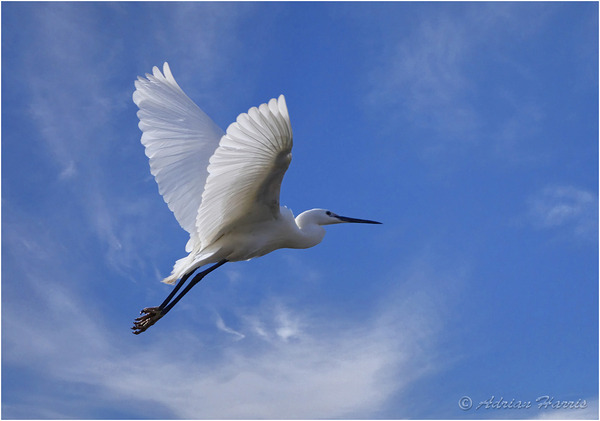 |
Egret in Flight.
(Click
photo for larger Image)
Panasonic GX8 with Olympus 75-300 Mk2. 1/2,000th. F6.5 at 258mm
(FF516mm). ISO400.
Comment: Although this Olympus lens focuses a little slowly,
it still nails the
subject.
Tip: Do not zoom in to close until you are experienced at
tracking birds in flight, otherwise you could lose them out of
the focus area. It is easier to obtain focus when birds have a
plain background.
|
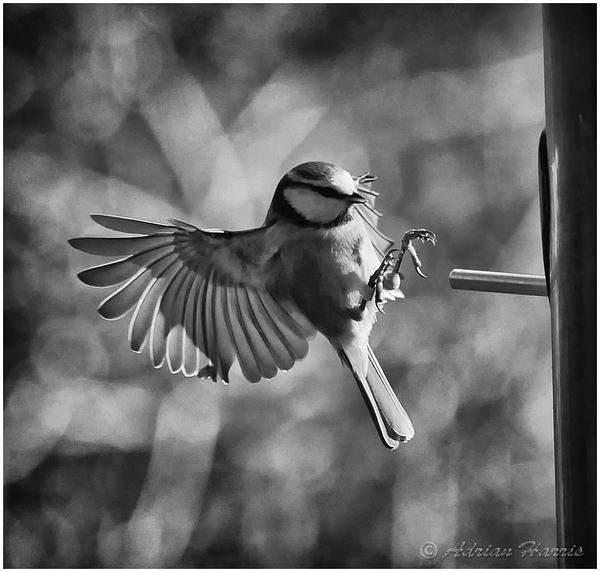 |
Blue Tit arrives
at a feeder.
(Click photo for
larger Image)
Panasonic GX8 with Olympus 75-300 Mk2. 1/6,400th. F3.5 at 100mm
(FF290mm). ISO1600.
Comment: Using Panasonics 'Pre-Burst' mode at 40fps makes shots like this
almost to easy.
Tip: Pre-setting manual focus is essential for a
pre-burst shot of this type, as you are pointing the camera into
what is effectively a blank space, so it will naturally focus on
the background.
(Pre-burst is a special video stills crop mode, hence the
strange FF equivalent focal length)
|
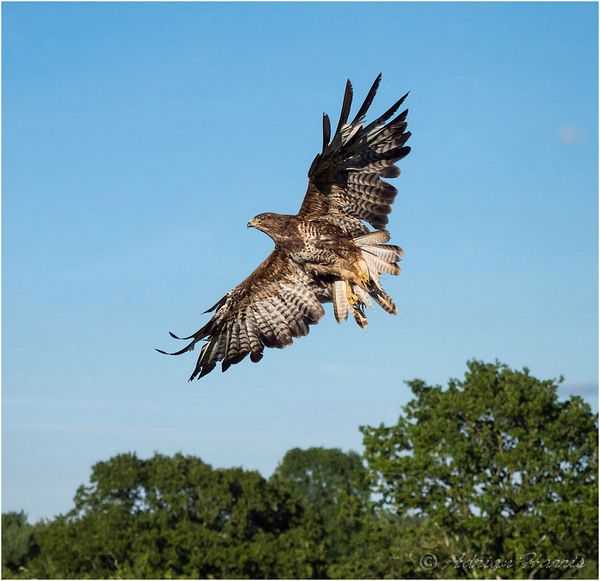 |
A Hawk takes flight
over Dartmoor.
(Click photo for
larger Image)
Panasonic GX8 with Olympus 40-150 Pro. 1/10,000th. F3.5 at 40mm
(FF80mm). ISO400.
Comment: Fast shutter speeds are essential to freeze
birds in flight.
Tip: With nature it is important to anticipate behaviour,
learn your subject.
High shutter speeds are needed for sharp 'birds in flight'
photographs.
|
Admittedly the very first incarnation of M43
- the ubiquitous Panasonic G1 - did make it a little difficult due to
its very substantial shutter lag, which meant I often missed that
'decisive moment'. But I dipped back in big time when Panasonic launched
their rangefinder style GX7 a few years back and with in-camera
stabilisation and no shutter lag at all, what a gem that little
masterpiece of a camera proved to be. However the small M43 sensor did make it a
little tricky to keep noise levels acceptable when light levels became
dire during indoor sports, especially as I originally only had very slow
kit lenses.
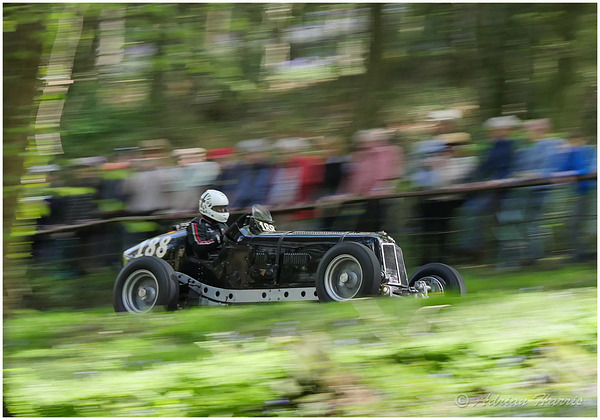 |
Vintage ERA GP
car at Wiscombe Hill Climb in Devon.
(Click photo for
larger Image)
Panasonic GX8 with Olympus 40-150 Pro. 1/80th. F3.5 at 50mm
(FF100mm). ISO800.
Comment:
Superb in-camera stabilisation allowed smooth slow speed
panning shots
with this non-stabilised Olympus lens.
Tip: Panning using a slow shutter speed creates the sense
of speed and motion. If this was
shot using a high shutter speed it would have looked like a
parked car!
|
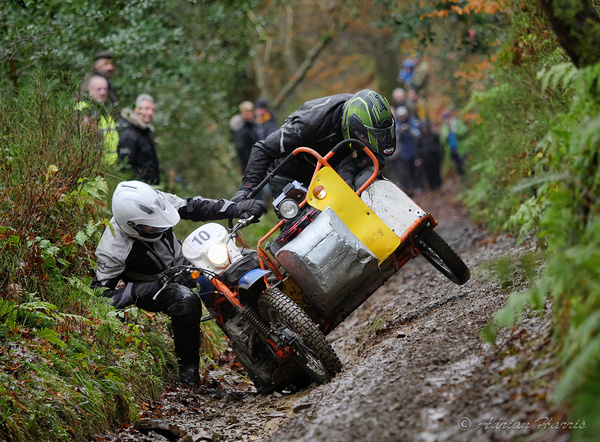 |
Tipping Point,
unlucky competitors crashing at Fingle Bridge.
(Click photo for
larger Image)
Panasonic GX8 with Olympus 40-150 Pro. 1/400th. F2.8 at 135mm
(FF270mm). ISO800.
Comment:
The fast f2.8 aperture allowed me to freeze action even in dark
woods during winter.
Tip: Here a fast shutter speed enabled me to freeze
the moment of no return and
the fast f2.8 lens allowed subject isolation while keeping the
action in context.
|
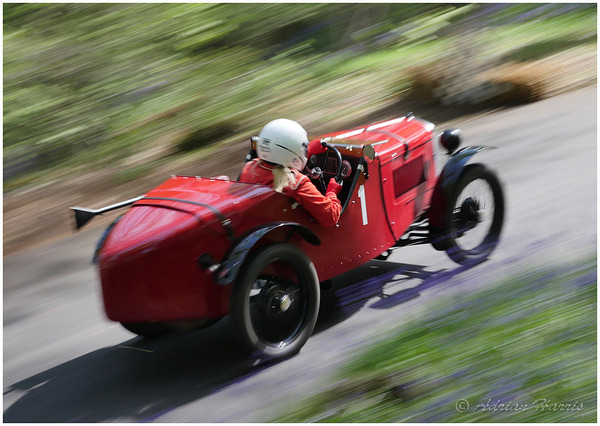 |
Vintage racer
approaching chequered flag at Wiscombe Hill.
(Click
photo for larger Image)
Panasonic GX8 with Panasonic 12-35 Pro. 1/20th. F6.3 at 30mm
(FF60mm). ISO200.
Comment:
Superb in-camera and lens stabilisation enabled this dramatic
ultra-slow speed shot.
Tip: Motor sport is about action, use a slow shutter
speed to reveal that movement.
|
Then along came the GX8 and Fast
Glass.
I realised that fast pro lenses would help
quite a bit, so bit the bullet and purchased the Olympus 40-150 f2.8
Pro, originally specifically to shoot indoor Roller Derby. That proved a
great move as I could now shoot at both a higher shutter speed and with
lower ISO at the same time.
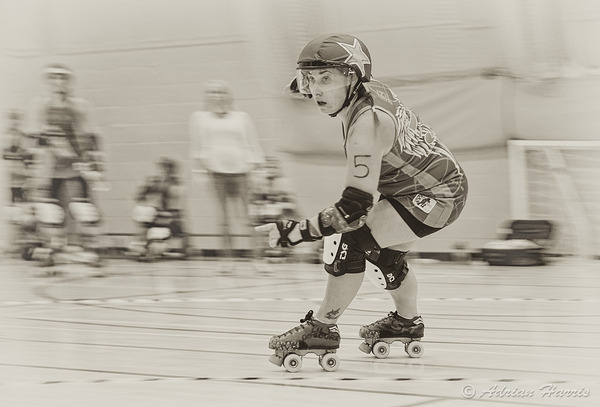 |
SWAT Roller Derby
- a Jammer with the stare of a gunfighter.
(Click photo for
larger Image)
Panasonic GX8 with Panasonic 12-35 Pro Lens. 1/100th. F2.8 at 35mm
(FF70mm). ISO800.
Comment: The small fast Panasonic pro lens was ideal when shooting from
within the tight confines
of the inside of a packed Roller Derby track during this
championship bout.
Tip: Using a slow shutter emphasised the speed of this
Roller Derby Jammer. When shooting
from the middle of the track a lot of referees are skating
between you and the action, so use
manual focus to ensure a good hit rate, and keep tucked in tight
or you will get hit.
|
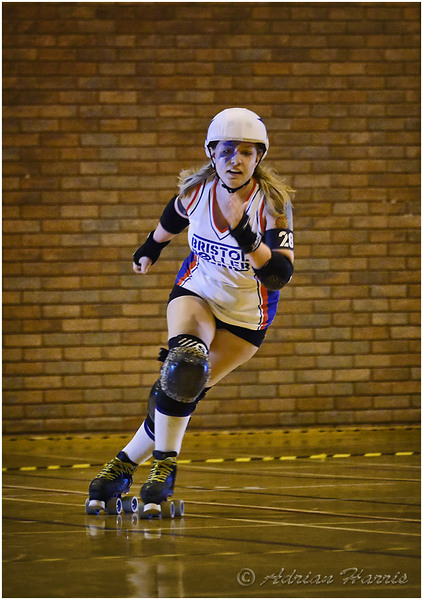 |
Bristol Roller
Derby Jammer powering out of a turn.
(Click photo for
larger Image)
Panasonic GX8 with ??? Pro lens. 1/200th. F2.8 at 106mm
(FF212mm). ISO3200.
Comment:
This sports hall had the poorest lighting I have ever worked in.
Not only was it very
dark, the
colour balance was horrendous and necessitated a white Card to
set WB.
Tip: Getting down low will emphasise an athletes power.
Some sports halls flickering LED lighting will cause banding
if using electronic shutter.
Take a white card to set white balance if lighting is tricky.
|
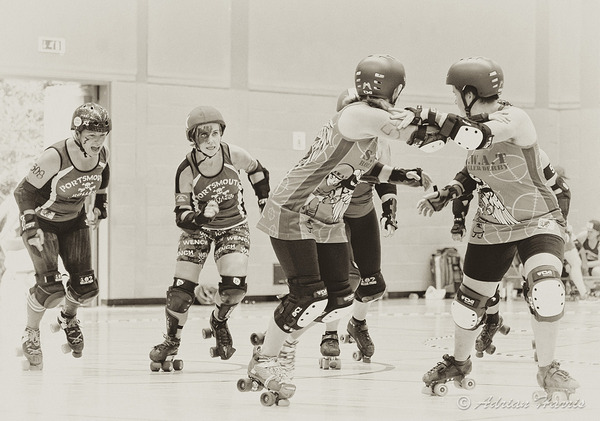 |
Portsmouth Roller
Derby make a charge at SWAT.
(Click photo for
larger Image)
Panasonic GX8 with ??? Pro lens. 1/250th. F2.8 at 64mm
(FF128mm). ISO1000.
Comment: For many reasons Roller Derby tournaments can be very difficult
to shoot well, here
turning
the colour image to monochrome has helped to alleviate a
distracting background.
Tip: Roller Derby is 'messy' to photograph at the best of
times because so many of the
athletes have their back to you during the bout. So look out for
moves which provide a
story telling interaction between opposing teams.
|
Then a year ago Panasonic brought out their
latest flagship, a slightly larger and improved GX7 replacement, the
GX8. And although the earlier model is adequate for action, this new GX8
was lightning fast in every respect. All control operations responded
without lag, as did both the shutter and the focus, which with the
Olympus 40-150 f2.8 Pro seemed to lock on instantaneously - even in
extremely poor light - and when using it with the matching Olympus 1.4x
teleconverter.
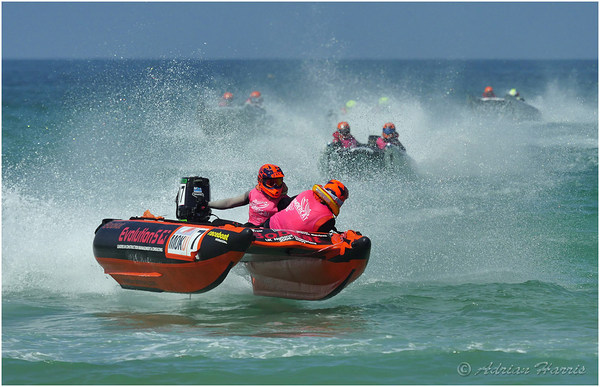 |
Thundercat Racing at
Fistral Beach, Cornwall.
(Click
photo for larger Image)
Panasonic GX8 with Olympus 40-150 Pro & 1.4x. 1/6,400th. F4.5 at
210mm (FF420mm). ISO400.
Comment:
Here an Olympus 1.4x teleconverter was added to extend the
40-150 Pro's focal range
to 210mm, which enabled capturing shots like this from the
beach.
Tip: Use a high shutter speed to ensure a sharp image.
Using a fast lens will help
isolate the front runner from the chasing pack.
|
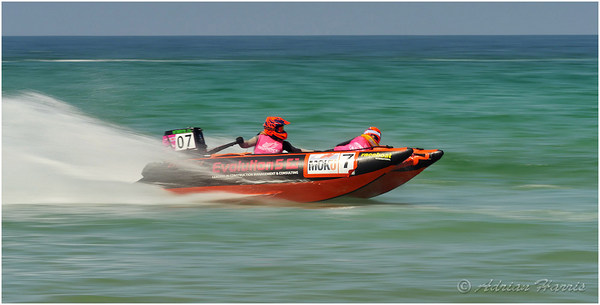 |
A Thundercat races
along the beach front
at Fistral.
(Click photo for
larger Image)
Panasonic GX8 with Olympus 40-150 Pro & 1.4x. 1/50th. F11 at
140mm (FF280mm). ISO200.
Comment:
Using Panasonics 'Pre-Burst' mode at 40fps makes shots like this
almost to easy.
Superb in-camera stabilisation allowed smooth slow speed panning
shots with this lens.
Tip: When panning always twist smoothly from your
waist to follow the action. Use a slow burst
mode to shoot because race boats bump across the water, and at
slow shutter speeds many
panned shots could suffer from blurred vertical movement..
|
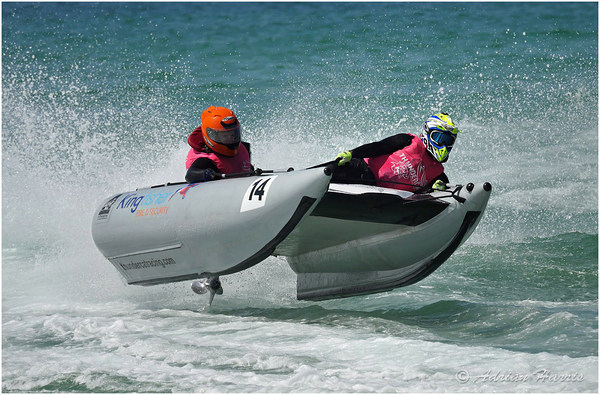 |
Thundercat Racing
at Fistral - Leader of the Pack.
(Click photo for
larger Image)
Panasonic GX8 with Olympus 40-150 Pro & 1.4x. 1/5,000th. F5.6 at
210mm (FF420mm). ISO400.
Comment:
Razor sharp close-up shots like this were handled effortlessly
all day. However
frequently changing camera settings for different effects
throughout the day meant that I accidentally used to high a
shutter speed in the shot which froze the propeller motion!
Tip: Use an appropriate shutter speed for the type of
photo you want. To prevent silly errors, preset camera memory
with basic settings, one for panning shots and one for freezing
action.
|
At last a M43 camera setup that would
allowed me to compete on equal terms.
Well that's what I felt convinced I now had,
but the proof of the pudding is in the eating, and as the saying goes:
'put up, or shut up'. So after reading once more in a very popular
photography forum that M43 is 'no good for Birds in Flight, or Action
Sport', I thought I had better look back to see if I did in fact
photograph any of these successfully during 2016 before I replied.
Fortunately I did find a few relevant events that I had attended, (but
it seems I photographed no ball sports this year). However I hope there
is enough of a selection of photographs here taken during 2016 to
convince any doubters that when it comes to action of any sort, M43 is
now more than just 'adequate'.
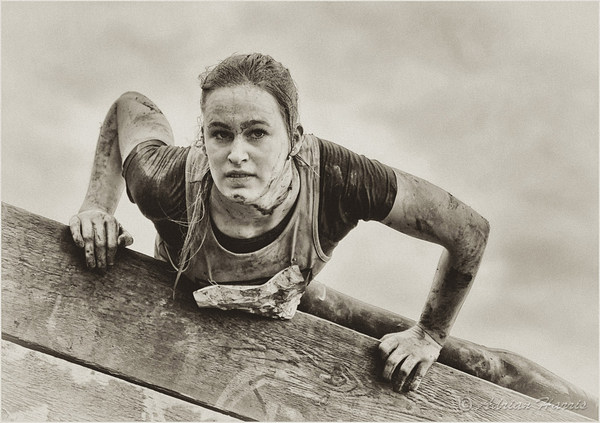 |
Over the Fence -
Rock Solid 2016 obstacle race at Escott Park.
(Click
photo for larger Image)
Panasonic GX8 with Panasonic Pro lens. 1/1,600th. F2.8 at 35mm
(FF70mm). ISO400.
Comment: It was a dark grey day, the colours were dull
and everyone was covered in mud.
Tip: Position yourself behind blind obstacles and wait
for competitor to look up in surprise.
Turn image to monochrome to reveal the grittiness of the event.
|
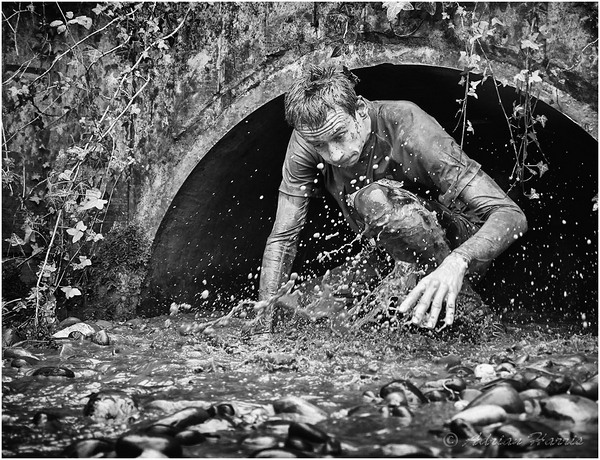 |
Another Wet Tunnel -
Rock Solid 2016 at Escott Park.
(Click
photo for larger Image)
Panasonic GX8 with Panasonic 12-35 Pro. 1/640th. F2.8 at 26mm (FF52mm). ISO800.
Comment: This was a very dark location so increase ISO to
enable a sharp shot.
Tip: Get in close and low, wait for the water splash and
look out for great facial expressions.
|
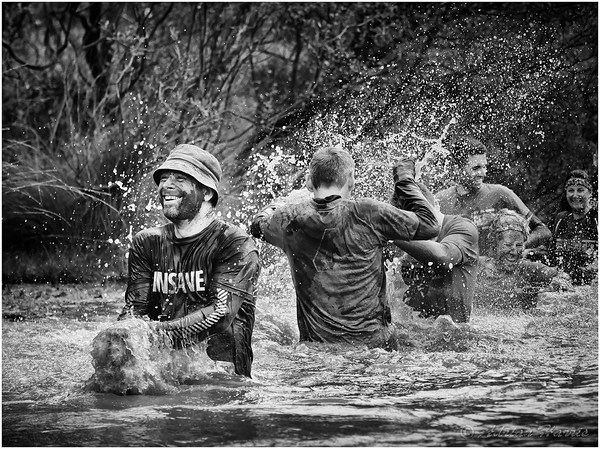 |
Off with the Mud - The Commando
Challenge 2016 event.
(Click
photo for larger Image)
Panasonic GX8 with Olympus 40-150 Pro & 1.4x. 1/3,200th. F2.8 at
64mm (FF128mm). ISO800.
Comment: This flooded pathway was seriously cold and
provided great photographic opportunities. Unfortunately the sun
was facing the camera and just out of shot to the right.
Tip: Use a high shutter speed to freeze the water
droplets and wait for peoples expression
or reaction before pressing the shutter. Keep your distance to
keep the camera dry.
|
So do the big question is do you need
the latest M43 camera and expensive Pro lenses to shoot Birds in Flight
and Action Sport ?
In brief 'NO'. I have used mainly fast glass
and my newest M43 camera for all these examples posted in this article,
but have been shooting BIF and Action Sport for years with M43.
Depending on what sports you are photographing and in what lighting
conditions you are in, any M43 camera and a kit lens can get you great
results. The latest and best kit just makes it a lot easier, and also
allows photographers to take shots in certain conditions that they
previously would not have been able to. Living in the UK and blessed
with frequent dark grey skies, every little improvement helps a lot.
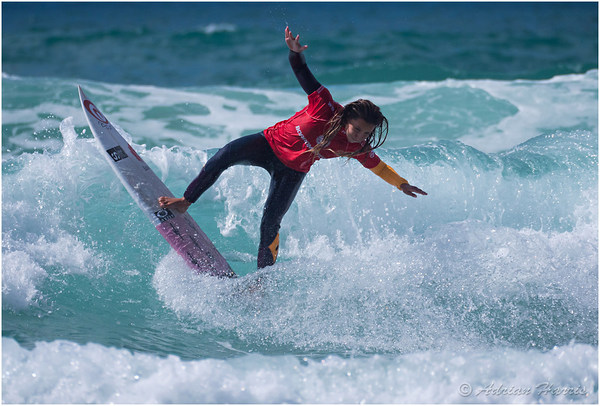 |
World Surfing
Champs at Fistral 2016 - 6a.
(Click photo for
larger Image)
Panasonic GX8 with Panasonic 100-400. 1/4,000th. F6.3 at 364mm
(FF728mm). ISO400.
Comment: This first tryout for my new Pana-Leica 100-400 lens was
on the finals day of the world surfing championships at Fistral Beach in
Cornwall, England ...and there were virtually no waves!
The action was so far out that I was stood in the sea at knee
level all day, and struggled to stand
upright and not drop my kit when the waves washed the sand from
under my feet!
Tip: Take a monopod to support the weight as holding long
telephoto lenses
up all day without support is out of the
question. And it can also it help with your stability!
|
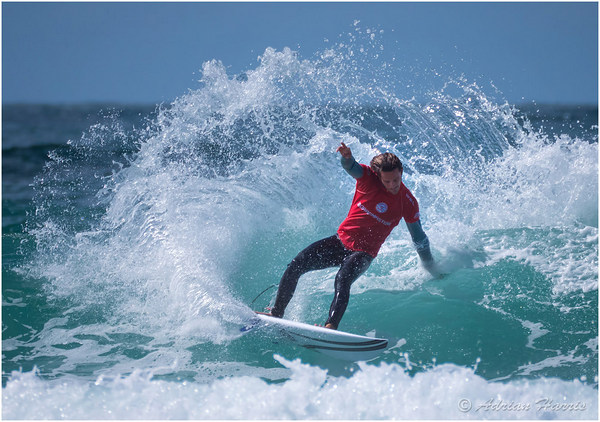 |
World Surfing
Champs at Fistral 2016 - 6b.
(Click photo for
larger Image)
Panasonic GX8 with Panasonic 100-400. 1/3,200th. F6.3 at 40mm
(FF800mm). ISO400.
Comment: Still no big waves, but the worlds best surfers
can make good moves even on a small swell. The surfers face off
in pairs, so which one do you point the camera at?
Tip: Unless you know the sport very well, choose a
competitor to keep your camera pointed at,
otherwise you will tend to miss all the best moves from both.
Competitive surfers rarely
move in a smooth line suitable for panning shots, so use a very
high shutter speed to
freeze the action and water droplets.
(All these surfing images were heavily cropped, thank goodness
for the 400mm reach.)
|
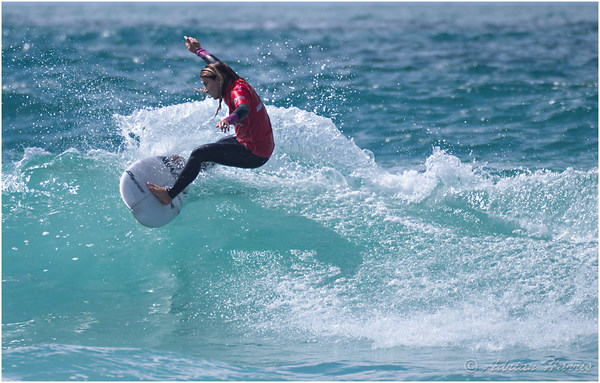 |
World Surfing
Champs at Fistral 2016 - 6c.
(Click photo for
larger Image)
Panasonic GX8 with Panasonic 100-400. 1/2,000th. F6.3 at 400mm
(FF800mm). ISO400.
Comment: During the semi's and finals the light had moved
to extreme left and slightly behind the surfers, but they were
still so far out there was no option for me to reposition for
better light.
Tip: Unless you know the sport well and can anticipate the
action, set camera on burst
to ensure you capture the best moment.
|
Why do I turn so many shots into
Black & White.
I love colour but as you will have noticed I
frequently turn images into monochrome and there are many varied reasons
for doing this. A black and white monochrome image will often add drama,
or a sense of time to a scene. Also by removing colours which can be
distracting, a viewer can be encouraged to focus attention on other
elements in the scene that the photographer wishes the viewer to notice.
In the early days of M43 when pushing the
equipment beyond what it could comfortably handle in low light, some
colour photos could look decidedly washed out, and in those cases
converting an image to black and white was often an effective way of
recovering an almost unusable image. The same scenario also applies when
shooting inside some sports halls where the lighting used is not full
spectrum and hence will not allow recording of proper colour, which
leaves black & white as the only option.
However, sometimes it is simply because I am
in a 'Black and White and Monochrome' photo-group and enjoy both colour
and monochrome photography.
Addendum: November 2019 Update ...
For the last two and a half years since I
wrote this article I have been shooting fast action, many sports, plus
birds and Dragonflies in flight with the Olympus EM1-Mk2 and what a
revelation it has been. The 20Mp sensor equipped Panasonic GX8 was and
still is a very capable camera, but for fast action, sports in low
light, and for acquiring fast focus on birds flying in front of a very
busy background, the EM1-Mk2 is streets ahead. Ultimately the image
quality is only slightly improved, but what really makes it leaps ahead
is the ease at which the Olympus EM1-Mk2 now makes it all so effortless.
I am currently writing up a side by side
real world comparison between the 2 cameras as a recent low light Roller
Derby match where many of the differences will be quite clearly seen, so
do the look out for the new link to that test article appearing in the
left side menu.
Article
© Adrian Harris
|
|
 |